Let us explore okayu, Japan's soothing rice porridge, a dish that many find comforting during difficult times. This traditional meal is light and easy on the stomach, making it ideal for those recovering from illness or simply seeking gentle nourishment. You may notice that okayu is not just a simple porridge; it can be tailored with a variety of toppings, allowing for personal preferences and seasonal ingredients to shine through.
In Japan, okayu holds a special place, closely tied to regional customs. Each area may have its unique spin on the dish, highlighting local flavors and ingredients. This adaptability speaks to the heart of Japanese cooking, where tradition meets creative expression, encouraging the use of what is available and fresh.
Preparing okayu is quite straightforward. Begin with a ratio of rice to water, typically 1:5 for a thicker texture or 1:7 for a lighter porridge. After rinsing the rice, combine it with water and bring it to a gentle simmer. Allow it to cook until the rice breaks down and achieves a creamy consistency.
Topping it with items like pickled vegetables, sesame oil, or even a sprinkle of seaweed elevates the flavor and adds nutritional value.
The significance of okayu goes beyond its taste; it embodies the essence of Japanese cuisine. Its simplicity reflects a philosophy that values balance and harmony, as well as a connection to nature through its use of seasonal ingredients.
Thus, enjoying okayu not only satisfies your hunger but also offers a glimpse into the cultural tapestry of Japan.
Table of Contents
Toggle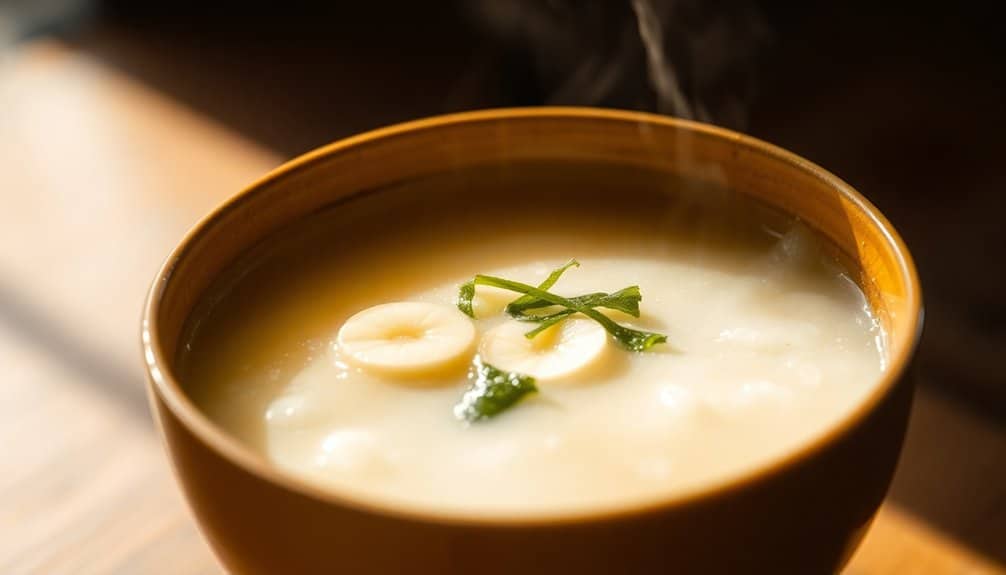
Japan's traditional rice porridge, okayu, serves as a comforting dish that embodies both simplicity and versatility. Making it can be a delightful experience, as it can be prepared on the stovetop, in a rice cooker, or with an instant pot. Each method has its charm, allowing room for personal creativity. Try incorporating various ingredients such as dashi stock for depth or sweet potatoes for a hint of sweetness. Given its nourishing properties, okayu is particularly beneficial when your digestion requires a gentler approach, making it an ideal choice during times of discomfort.
Begin your journey with okayu by rinsing the rice under cold water. This step removes impurities and contributes to a smoother texture. Pay attention to the water-to-rice ratio; finding that balance will help you achieve the porridge's ideal consistency. Feel free to enhance the flavor by adding your favorite garnishes. Chopped green onions can add a refreshing note, while a drizzle of sesame oil imparts richness. Sushi nori seaweed adds an interesting texture, enriching the dish as you explore your personal preferences.
Focus on mastering the cooking techniques; gentle simmering will coax out the flavors, yielding a warm and satisfying bowl. With practice, you'll find yourself able to create okayu tailored to your taste, all while appreciating its healthful advantages. Embrace this experience of cooking, and you'll soon enjoy not just the meal, but also the serenity it brings to your spirit.
You're about to investigate the cultural significance of okayu, and it's essential to understand that this simple food represents a comfort meal that's deeply rooted in traditional Japanese values, emphasizing the importance of humble, wholesome ingredients. As you examine the role of okayu in Japanese cuisine, you'll notice that it's not just a meal, but a symbol of comfort, warmth, and hospitality, reflecting the country's rich cultural heritage, with a history that spans centuries, and a significance that's still felt today, in every region, and every household. You'll see that okayu embodies traditional values, such as simplicity, humility, and respect for nature, which are fundamental to Japanese culture, and are reflected in the way the dish is prepared, served, and enjoyed, with attention to detail, and a focus on the beauty of simplicity.
Traditional Japanese cuisine revolves around fresh ingredients and the beauty of seasonal themes. Chefs hold simplicity in high regard, creating dishes where the natural flavors shine without heavy sauces or distractions. In this culinary world, local, fresh ingredients play a starring role, bringing authenticity and depth to each meal.
Fermented vegetables, such as pickles, are indispensable in Japanese cooking, providing a delightful burst of flavor. Seasonal elements enhance the dining experience, with cherry blossom-inspired dishes gracing tables in spring, beautifully reflecting Japan's respect for the changing seasons.
Looking deeper into Japanese cuisine, one can see how this steadfast commitment to simplicity has influenced culinary traditions across the globe. The emphasis on seasonal ingredients has fostered a newfound appreciation for simple, locally-sourced fare, encouraging more chefs to embrace these principles.
It's essential to remember that simplicity in Japanese cooking extends beyond the ingredients themselves; it also encompasses the artistry in presentation. Each dish is meticulously crafted to showcase its inherent flavors, inviting diners to immerse themselves in the experience. By valuing simplicity, Japanese cuisine has carved out a unique and universally appealing style, with seasonal highlights and fermented flavors at its core. This approach serves as a reminder of the beauty in simplicity, encouraging one to delve deeper into the art of Japanese culinary practices.
As you explore the rich landscape of traditional Japanese cuisine, you come to realize that its beauty lies in both simplicity and the emotional warmth it offers. Take Okayu, for instance. This dish brings back soothing memories, especially for those who have savored it during moments of illness or frailty. Its soft, easily digestible rice is an essential part of Japanese comfort food, serving not just as a meal but as a source of nourishment and solace.
Okayu's gentle characteristics are complemented by its notable healing properties, which aid in restoring energy. This makes it an integral component of Japanese culinary culture, where food is often intertwined with care and recuperation. Each region adds its own touch, resulting in various versions of Okayu, each unique with local toppings and preparation styles that showcase regional flavors and preferences.
The historical roots of Okayu, tracing back to China, have been beautifully integrated into Japanese tradition over the years. As you savor this dish, you gain a deeper appreciation for its role in both comfort and cultural heritage. Understanding these layers adds richness to your experience, connecting you to a long-standing lineage of care and nourishment.
Okayu holds a special place in Japanese culture, with roots that stretch back roughly 1,000 years. This comforting rice porridge not only nourishes the body but also reflects the rich tapestry of Japan's culinary practices, which prioritize seasonal ingredients.
Exploring okayu unveils a world of local variations, each adapting to regional tastes and traditions. In many households, it's a staple food, typically enjoyed with a large ceramic spoon, encouraging a slow and mindful eating experience. Preparing and consuming okayu is a homage to Japan's cultural heritage, where respect for tradition plays a pivotal role.
You'll notice that okayu often appears in various festivities, highlighting its significance during celebrations and customs. Its ability to comfort and provide sustenance makes it an integral part of Japan's culinary identity, where the emphasis on seasonal ingredients further enhances its value. As you delve deeper into okayu, it becomes clear that it is more than just a dish; it embodies the essence of Japanese culture and its enduring respect for tradition.
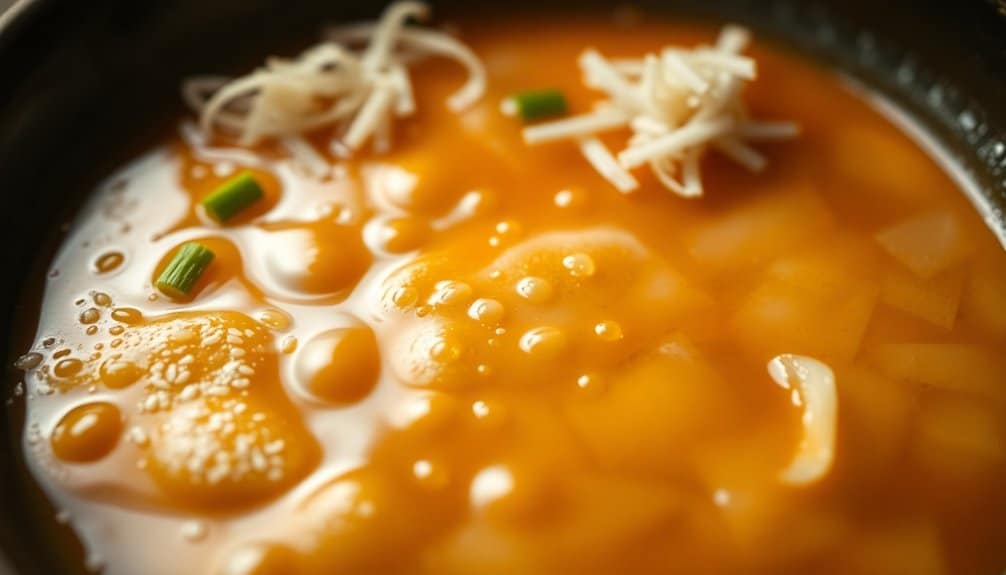
You're about to investigate the various types of okayu, including Taki Kayu, which involves cooking raw rice grains from scratch, Ire Kayu, a method that uses pre-cooked rice, and other types that vary depending on the rice used, such as Japanese short-grain rice. As you learn about these methods, you'll notice that they differ significantly in terms of texture, cooking time, and usage, with some being more preferred than others due to their ease of preparation, or lack thereof. You'll discover that the differences between Taki Kayu, Ire Kayu, and other types, such as the thickness, stickiness, and flavor, are largely determined by the cooking method, and the type of rice used, which can be adjusted to suit your preferences.
It seems you're seeking information about "Taki Kayu" in relation to Japanese cuisine, particularly okayu. It can be rather perplexing, given that "Taki Kayu" does not have known connections in traditional settings. Understanding this might help you navigate the confusion surrounding it.
Okayu, often referred to as rice porridge, holds a special place in Japanese culinary tradition. It is crafted using Japanese short-grain rice simmered in water until it transforms into a comforting, soft porridge. The simplicity of okayu makes it a favored choice for those recovering from illness, as it's gentle on the stomach and nourishing.
Unlike in Chinese cuisine where congee is a staple food, okayu tends to be reserved for recovery or light meals in Japan. This distinction may contribute to the misconceptions around its consumption. To prepare this dish, one simmers rice with more water than usual, allowing it to break down and achieve that lovely porridge-like texture.
Given the scarcity of detailed information on Taki Kayu, it would be beneficial to explore other rice-based dishes that showcase the essence of Japanese cooking. Zosui, a rice soup, and takikomi gohan, rice cooked with vegetables and seasonings, are excellent examples that offer broader insights into the variety of rice dishes cherished in Japanese cuisine. These dishes not only celebrate the versatility of rice but also reflect regional flavors and seasonal ingredients.
As you delve into the world of Japanese culinary delights, allow the understanding of these dishes to enrich your appreciation for the subtleties and traditions that characterize this exquisite cuisine.
One delightful type of okayu to explore is ire kayu. This dish involves simply adding pre-cooked rice to a warm liquid, a method that gently softens the grains. The Japanese term "ire" translates to "to put in," reflecting the essence of this technique. By cooking the rice twice, the grains absorb the liquid, producing a thicker and stickier texture, which comes primarily from the rice's natural starch.
Ire kayu holds a special place in Japanese households, particularly for those who prefer softer textures in their food. This makes it an excellent choice for individuals recovering from illness. As its history suggests, this dish is highly regarded for its straightforward preparation and comforting nature.
What's lovely about ire kayu is its versatility. You can easily customize it to suit your palate with various toppings, seasonings, and even different broths. While it often shines on its own, adding minimal toppings can enhance its appeal, making it harmonious with main dishes or side options like miso soup and pickles. Embracing the simplicity and comforting character of ire kayu allows one to appreciate its significance within traditional Japanese cuisine.
To create the perfect okayu, selecting the right rice is essential. Each variety carries unique characteristics that impact texture and flavor. Short-grain Japanese rice, for instance, is favored for its sticky texture, making it an excellent choice for this comforting dish. On the other hand, medium-grain Japanese rice offers a slightly varied texture that can also work well.
If you lean towards brown rice, be prepared for a longer cooking time. It demands more water and requires a bit of patience, but the nutty flavor can be quite rewarding. Japonica rice stands out as the most widely consumed variety in Japan, bringing a distinct taste and texture to your okayu.
Understanding these different rice types is crucial for achieving the desired consistency in your dish. Selecting the right one will influence not just the texture but the overall experience of your okayu. With this knowledge, you can confidently explore the art of making okayu, enhancing your culinary journey.
When preparing okayu, it's essential to use a considerable amount of water or dashi, gently boiling the rice until it reaches a soft, mushy texture. A donabe or a covered pot serves as the ideal cooking vessel, ensuring the right consistency. While the rice simmers, think about enhancing the flavor. A touch of salt or various toppings can elevate the dish and make it your own.
Monitoring the temperature and the rice's consistency is key to mastering this cooking method. You may find that adjusting the cooking time and the water ratio is necessary to get it just right. Traditional simmering requires both skill and patience, and it rewards you with a comforting bowl of okayu. Different techniques like taki-kayu or ire-kayu can be explored to achieve your desired texture.
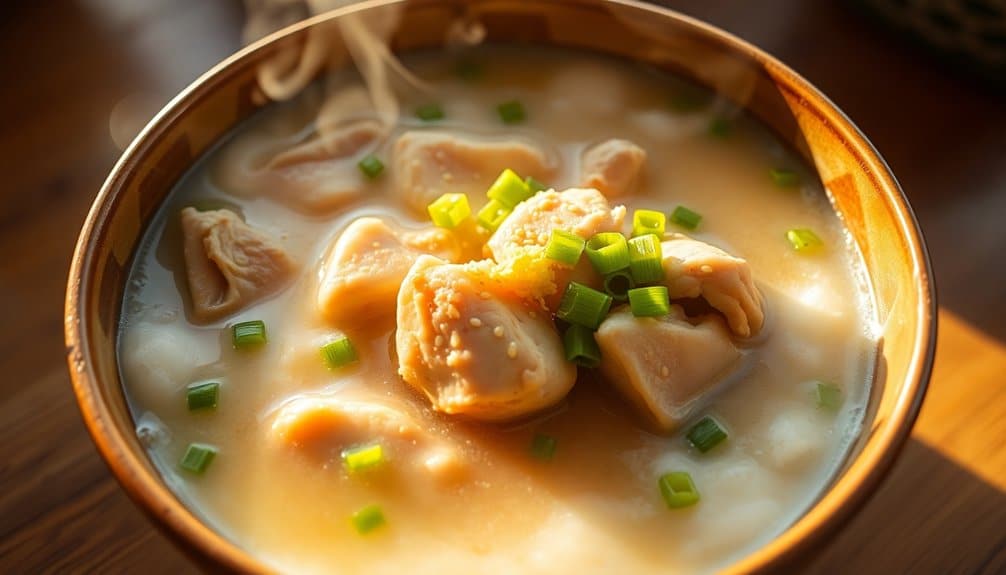
To truly appreciate the essence of okayu, we must turn our attention to the vital ingredients that serve as its foundation. The right elements will not only elevate the flavor but also enhance the texture of this beloved dish. Let's delve into these key components.
First and foremost, Japanese short-grain rice is the star of okayu. Known for its sticky texture, this rice variety absorbs water beautifully, resulting in a delightful consistency that envelops each grain in warmth. Using the right type of rice sets the stage for your creation.
Next, consider the dashi stock. It's an excellent choice to infuse your okayu with a deeper, more complex flavor. Dashi, made from kelp and bonito flakes, introduces umami, a crucial element in Japanese cuisine. This simple addition can transform your broth into a nurturing embrace.
A pinch of salt can be applied as well, enhancing the dish without overwhelming it. This small touch encourages the other flavors to shine, providing a well-rounded palate experience.
Lastly, let's not forget the toppings. You have an array of options to choose from—umeboshi for its tangy kick, sesame seeds for crunch, and chopped scallions to lend freshness. These toppings allow you to personalize your okayu, bringing in textures and tastes that appeal to your senses.
Selecting these ingredients requires intention and care. Each component plays a significant role in crafting a bowl of okayu that warms both body and spirit. Remember, the quality of what you choose will ultimately determine the success of your dish. Mindfully choosing your ingredients can lead to an authentic and satisfying okayu, a true reflection of these culinary traditions.
Okayu has long been cherished for its nutritional benefits, making it a delightful addition to your meals. This humble rice porridge is not only rich in fiber but also low in calories, serving as a nourishing choice for anyone mindful of their health. Packed with essential vitamins and minerals such as manganese and magnesium, okayu aids in supporting your overall wellness.
The fiber content within okayu plays a crucial role in promoting digestive health. It is gentle on the stomach, making it an excellent option for those experiencing digestive discomfort. Many find that incorporating okayu into their daily routine leads to noticeable improvements in their digestive system, helping to reduce inflammation and soothe the gut.
One of the lovely aspects of okayu lies in its prebiotic properties. These properties assist in repairing and maintaining the lining of your gastrointestinal tract, which is essential for cultivating a healthy gut environment. It invites a balance that encourages the growth of beneficial bacteria, promoting optimal digestive function.
You may wish to personalize your bowl of okayu with various ingredients, enhancing both flavor and nutritional profile. Whether adding seasonal vegetables, pickles, or a dash of soy sauce, the choices are numerous and can elevate the meal's benefits. By inviting okayu into your diet, you take a thoughtful step towards nourishing your body.
The beauty of okayu lies not only in its simplicity but also in its ability to nurture. Embracing this dish will lead you on a path to improved health and well-being—a choice truly worthy of consideration.
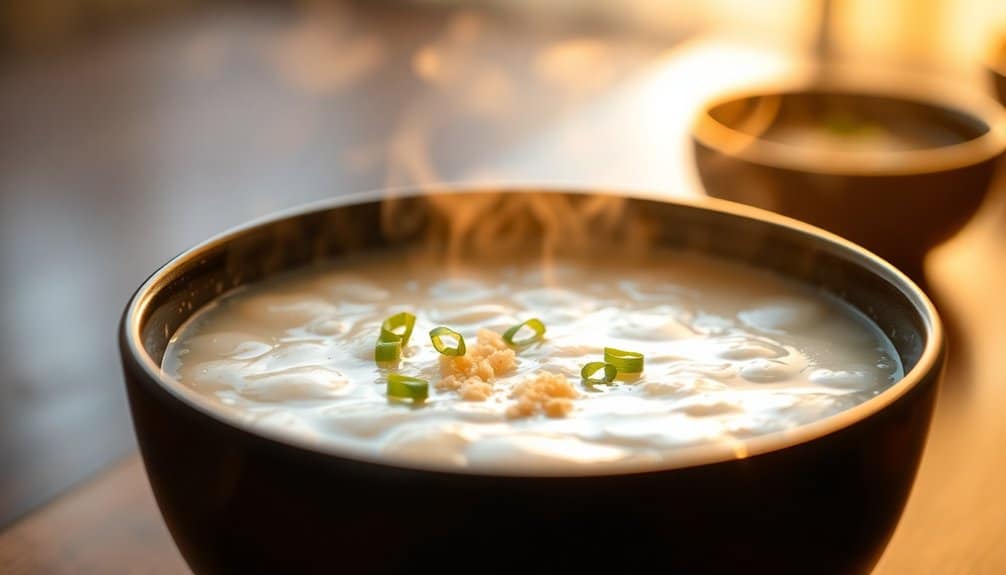
Embracing the art of preparing okayu, let's delve into the essential techniques that will elevate this traditional Japanese dish. Begin by selecting the right type of rice; while Japanese short grain rice is the classic choice, medium grain or brown rice can also create a delightful porridge. Each type contributes its own texture and flavor profile.
To achieve a rich and thick consistency, a rice-to-water ratio of 1:7 is ideal. This will create a luxurious porridge that comforts the soul. A pinch of salt is a subtle enhancement that brings forth the umami flavors, making every spoonful a delightful experience.
Consider various toppings to personalize your dish. For example, freshly chopped green onions or a sprinkle of kizami nori can add brightness and a beautiful presentation. If you wish to amplify the savory depth, incorporating dashi stock—either from dashi powder or homemade broth—will enrich the flavor significantly.
Creating okayu is all about balance. As you cook, adjust the consistency according to your preference, ensuring that it is neither too thick nor too thin. With these techniques, you can craft a nourishing and authentic okayu that embodies the essence of Japanese culinary tradition.
Japan's regional diversity is beautifully reflected in the traditional uses of okayu, a comforting rice porridge. Each area showcases this dish in its own distinctive manner, influenced by local customs and historical practices. For example, in the Kanto region, okayu is often consumed during illness, serving as a gentle remedy ideal for soothing an upset stomach. In Kansai, this dish enjoys a place as a breakfast staple, offering a warm, nutritious start to the day.
Take a look at how different regions honor okayu through their unique traditions:
| Region | Traditional Usage |
|---|---|
| Kanto | Eaten when ill |
| Kansai | Commonly consumed for breakfast |
| Kyoto | Nanakusa-gayu on New Year |
| Sakyo-ku | Azukigayu at festivals |
This dish has graced Japanese tables for approximately 1,000 years, embodying not only nourishment but also a historical significance that connects generations. Its role extends beyond mere sustenance; okayu is cherished for its therapeutic qualities as well, thanks to its soft, easily digestible texture that offers comfort when one feels unwell. Embracing these regional traditions allows us to appreciate the depth and richness of okayu's role in Japanese culture.
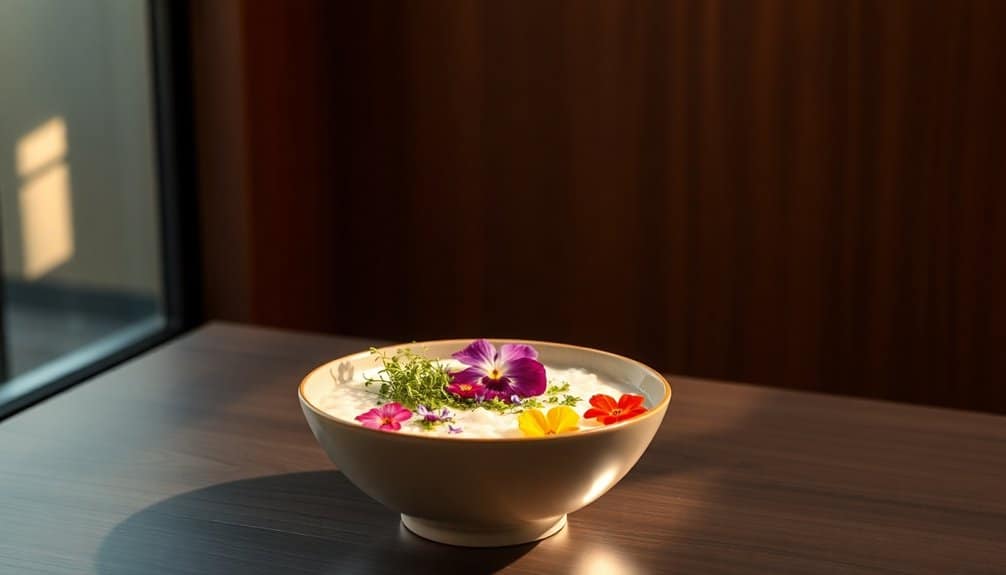
Modern variations of okayu have become quite delightful, reflecting evolving tastes and culinary creativity. You'll find that these adaptations open the door to a medley of flavors, thanks to the inclusion of an array of ingredients. Fresh vegetables, legumes, and aromatic spices enrich the texture and nutritional content, ensuring each bowl of okayu is a wholesome experience.
Take, for instance, nanakusa-gayu. This variation draws upon the essence of traditional herbs and blends them with radish and turnip, bringing a touch of seasonal freshness. Meanwhile, azukigayu introduces red beans or soybeans to the mix, resulting in a hearty and comforting porridge. If you crave something more vibrant, the popeye version, featuring abundant green spinach, offers a delightful green hue and a burst of nutrients.
For those seeking a savory twist, the beef variation showcases tender, simmered beef tendons, enhancing the dish with deep, rich flavors. These modern interpretations of okayu reveal the artistry of contemporary cooking, allowing you to explore and enjoy unique combinations while staying true to the dish's comforting essence.
Creating your own interpretations of okayu could be a gratifying journey. With each variation, you have the opportunity to balance flavors and tailor the dish to your preferences and dietary needs. This evolution of okayu signifies its enduring presence in Japanese cuisine, inviting you to enjoy and share these delightful flavors with others.